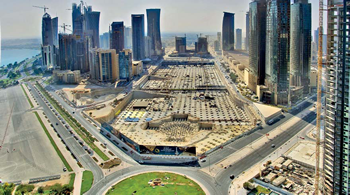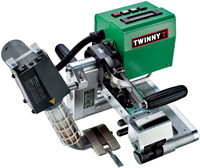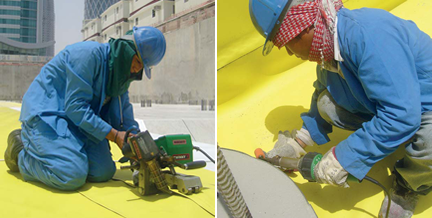 The Qatar National Convention Centre, one of the world’s largest construction projects, is currently underway in Doha, Qatar. Upon completion, the 100,000 square meter structure is expected to be a venue of choice for regional and international conventions, exhibitions, gala events, concerts, weddings and banquets. This bold design incorporates a three-story car park underneath the modern four-story building.
The Qatar National Convention Centre, one of the world’s largest construction projects, is currently underway in Doha, Qatar. Upon completion, the 100,000 square meter structure is expected to be a venue of choice for regional and international conventions, exhibitions, gala events, concerts, weddings and banquets. This bold design incorporates a three-story car park underneath the modern four-story building.
Confidence in Leister
For this mega-project, about 135,000 square meters of 2 mm PVC geomembrane Sikaplan WP1100-20HL2 were laid as a single layer, a scale that posed a great challenge — even for the waterproofing installation, company BMC Qatar — especially as the work needed to be completed in the span of one year. For the laying work, the professionals at BMC Qatar relied as always on welding equipment from Leister.
 “Good equipment is the key to success,” said SIKA project manager Ing. Hani Fikry Zaki. “We have never had any problems with Leister equipment; quite the contrary, the welding machines impressed us again and again with their high welding speed even under the harshest conditions.”
“Good equipment is the key to success,” said SIKA project manager Ing. Hani Fikry Zaki. “We have never had any problems with Leister equipment; quite the contrary, the welding machines impressed us again and again with their high welding speed even under the harshest conditions.”
During summer, temperatures in the emirate can reach up to 50 C°. At these temperatures, reliable equipment is essential. Problem-free thanks to the combi-wedge Four TWINNY S and two TWINNY T combi-wedge welding machines from the long-established Swiss company were employed. Optimum welding seams were attained using combi-wedge technology; the welding seam is heated only where actual welding occurs.
Additionally, the use of hot air removes dust from the seam, providing an optimal surface before welding.
Regulated control
The design of the regulated TWINNY T incorporates a digital display. This display denotes both temperature and welding speed. Despite being lightweight — just 6.9 kilograms — the TWINNY T can reach a welding speed of up to 3.2 meters per minute, depending on material. In Doha, a total of 80 kilometers of PVC membranes were welded with a double weld seam; consisting of two 15 mm weld seams, and a 20 mm wide test channel. After welding the membranes together, the channel was used to test (successfully) the leak tightness with compressed air using a testing device — with injector needle — from Leister.
Vertical, horizontal, diagonal
About 100 kilometers of welding seams were produced with 16 TRIAC S hot-air hand tools and two TRIAC Drive PID semi-automatic welding machines — the TRIAC Drive PID is actually a hot-air hand tool outfitted with a drive motor that can be used to weld less accessible spaces — vertically, horizontally or diagonally — more quickly and hence more productively than a hot-air hand tool. The two TRIAC Drive PID welding machines were especially used for the waterbars, the TRIAC S hot-air hand tools for the edging and the reinforced foundation supports.
 |
Evidence provided
Once again, Leister has proven that its equipment can be continuously operated under the harshest environmental conditions without failure, a feat confirmed by Sika Project Manager Ing. Hani Fikry Zaki. “Leister equipment continued to work without problems when products from other suppliers long since needed a break!”
Christophe von Arx and Roland von Ah work for Leister Process Technologies, www.leister.com.
|
PROJECT DETAILS Main Contractor: Six Construct / Midmac |











